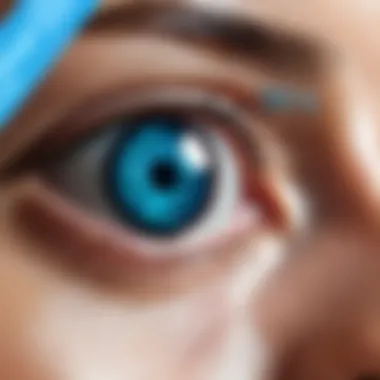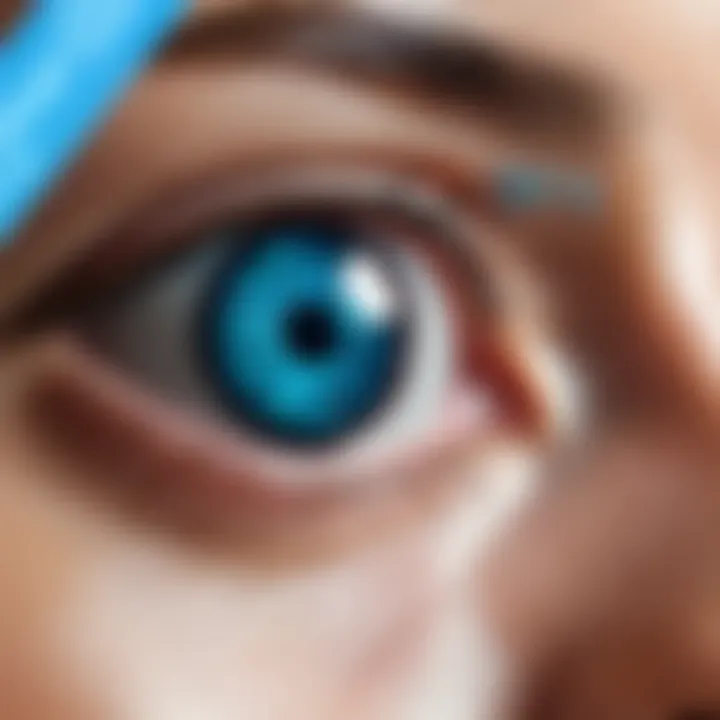Innovative Applications of Computer Vision Technology


Overview of Topic
Computer vision is a field of artificial intelligence that enables machines to interpret and process visual information from the world. The ability to analyze images and videos has transformed numerous industries, offering solutions that were previously unimaginable. Its integration into various sectors signifies not just technological advancement but a shift towards a more efficient and automated future.
Computer vision has become significant in today's tech landscape, shaping the way businesses operate. From healthcare where it assists in diagnostics to automotive industries with self-driving cars, the applications are vast and impactful. As we look back, the evolution of computer vision has been remarkable, evolving from simple optical character recognition systems to sophisticated deep learning models that can surpass human performance in certain tasks.
Fundamentals Explained
To grasp the importance of computer vision, understanding its core principles is essential. Computer vision employs algorithms and models to analyze visual data. Key terminology includes:
- Image Processing: Techniques to enhance or manipulate images.
- Object Detection: Identifying objects within an image.
- Neural Networks: Computation systems inspired by the human brain, crucial for deep learning.
The foundational knowledge also encompasses the understanding of how images are represented in digital form and the basic principles of machine learning that power many computer vision techniques.
Practical Applications and Examples
Computer vision has a plethora of real-world applications. Here are a few significants examples:
- Healthcare: Used in medical imaging for disease detection and diagnosis, computer vision algorithms assist in identifying cancerous cells in radiology images.
- Automotive: Self-driving cars, such as those developed by Tesla, employ computer vision to perceive their surroundings, ensuring safety and navigation.
- Security: Facial recognition technology enhances surveillance systems, aiding in public safety measures and identity verification.
Demonstrations of its application can be seen in projects like building a simple object detection system using TensorFlow. Here’s a basic example of how one might approach object detection:
Advanced Topics and Latest Trends
Recent advancements continue to push the boundaries of computer vision. The field is leaning towards techniques like Generative Adversarial Networks (GANs) that can produce realistic images from scratch. Furthermore, integrating augmented reality with computer vision is paving the way for applications that merge digital and physical worlds seamlessly. Future trends may include improvements in real-time analysis and enhanced accuracy in various environments.
Tips and Resources for Further Learning
For those looking to deepen their understanding, the following resources are valuable:
- Books: "Deep Learning for Computer Vision with Python" by Adrian Rosebrock.
- Courses: Coursera’s “Introduction to Computer Vision�” covers the basics and advanced topics.
- Online resources: Websites like the computer vision section of Wikipedia provide comprehensive information.
Tools like OpenCV offer practical applications for implementing computer vision projects. The integration of these resources will provide a solid foundation in the field.
Prologue to Computer Vision
Computer vision stands at the intersection of artificial intelligence and visual computing. It is a discipline focused on enabling machines to interpret and make decisions based on visual data. The importance of computer vision cannot be overstated. It drives innovation across diverse sectors, from healthcare to automotive industries. As technology progresses, the demand for effective visual data analysis grows.
Understanding the basics of computer vision is essential. It is about teaching computers to see and analyze images and videos in a manner close to human perception. This capability has significant implications. For instance, in healthcare, computer vision can assist in analyzing medical images for diagnostic purposes. This enhances the speed and accuracy of disease detection. In retail, it transforms the shopping experience through automated systems that analyze customer behavior.
Moreover, the key components that contribute to computer vision include image processing, neural networks, and machine learning. These technologies work together to create models that can recognize patterns and objects. The evolution of deep learning, in particular, has made a profound impact on the development of powerful vision applications. As models improve, their robustness in various environments and scenarios also increases.
Considerations about computer vision technology include ethical implications and data privacy concerns. As systems become more integrated into daily life, understanding how they operate within social context is crucial. Issues surrounding surveillance and personal data management must be addressed carefully.
In summary, this article aims to illuminate the diverse applications of computer vision. Highlighting its relevance and potential, particularly in modern industry practices, lays a solid foundation for understanding its transformative influence on various fields. As we move into more advanced discussions, it is clear that mastering the principles of computer vision is essential for future innovations.
Fundamentals of Computer Vision Technology
Understanding the fundamentals of computer vision technology is essential for grasping its applications across multiple industries. This field encompasses a variety of methods and techniques that allow machines to interpret and understand visual information. One key benefit of computer vision is its ability to analyze large amounts of image and video data quickly, enabling various automated processes and decision-making systems.
Key Components of Computer Vision
The foundation of computer vision technology relies on several core components:
- Image Acquisition: This is the first step where images or video are captured through cameras or sensors. Without accurate data capture, all subsequent analysis can falter.
- Image Processing: Once images are acquired, processing techniques are applied to enhance the visual quality. Techniques such as noise reduction and contrast enhancement are crucial here.
- Feature Extraction: This step involves identifying significant characteristics within the image, such as edges, shapes, or colors. Features are vital for later classification tasks.
- Machine Learning Models: Models are trained using labeled data to recognize patterns and make predictions based on new inputs. This creates the backbone of many computer vision applications, powering tasks like object detection and facial recognition.
- Output Analysis: Finally, the processed information is analyzed to make informed decisions, potentially feeding into other systems or reporting back findings.
These components interact intricately, forming a system that allows machines to understand and act on visual data effectively.
Machine Learning and Deep Learning in Computer Vision
Machine learning plays a pivotal role in advancing computer vision capabilities. Initially, algorithms used in this field relied heavily on handcrafted features for analysis. Now, deep learning has revolutionized this approach, automating the feature extraction process. With the rise of neural networks, particularly convolutional neural networks (CNNs), machines can learn to represent complex patterns from raw pixels with minimal human intervention.
- Benefits of Deep Learning in Computer Vision:
- Accuracy: Deep learning models often achieve higher accuracy in image recognition tasks compared to traditional methods.
- Scalability: These models can be scaled easily with more data, improving performance over time.
- Versatility: Deep learning can be applied to various computer vision tasks, such as segmentation, object detection, and image generation.
Despite its advantages, implementing machine learning and deep learning in computer vision comes with challenges. Data privacy issues, the need for extensive data sets, and the requirement of substantial computational power can complicate development. However, when properly utilized, these technologies enhance the functionality and scope of computer vision applications substantially.
"Machine learning and deep learning significantly amplify the capabilities of traditional computer vision, enabling systems to learn and adapt rather than solely relying on defined rules."
Computer Vision in Healthcare


Computer vision technology is making significant advancements in the healthcare industry. Its integration into medical practices is not just innovative but also transformative. This technology enhances the accuracy and efficiency of diagnostics, offers new methods for treatment, and improves patient outcomes. Understanding how computer vision operates in this field is essential for professionals who aim to leverage its capabilities in clinical settings.
Medical Imaging Analysis
Medical imaging relies heavily on computer vision to analyze complex images from MRI, CT scans, and X-rays. Traditional approaches can be time-consuming and subject to human error. With computer vision algorithms, it is possible to automate the analysis, thereby ensuring greater precision.
"Computer vision can reduce the time required for image analysis, increasing overall efficiency in healthcare settings."
These algorithms assist in identifying abnormalities like tumors and lesions at an earlier stage, leading to timely interventions. For instance, deep learning models can be trained on vast datasets to recognize different types of cancers, contributing to improved survival rates. Moreover, models such as convolutional neural networks have shown remarkable accuracy in differentiating normal tissue from pathological states.
Furthermore, these systems can produce quantitative assessments, which can complement radiologist interpretations. Medical institutions are also exploring the possibility of using computer vision for real-time monitoring of surgical procedures. By providing instant feedback, it can help surgeons make better decisions during operations.
Disease Detection and Diagnosis
The application of computer vision extends beyond imaging to disease detection and diagnosis. For example, tools that analyze images from skin lesions can aid in diagnosing conditions like melanoma with higher accuracy. These systems utilize algorithms that learn from thousands of labeled images to distinguish between malignant and benign formations effectively.
In addition to skin conditions, computer vision plays a crucial role in diagnosing diseases from various imaging modalities. For instance, retinal imaging analyzed through computer vision can detect diabetic retinopathy, a prevalent complication of diabetes. Early detection is imperative to prevent blindness, and automated systems can make this process significantly faster.
Moreover, there is an increasing trend toward integrating computer vision with other technologies like telemedicine. This combination allows healthcare providers to conduct remote diagnostics efficiently, especially in underserved areas where access to specialists may be limited.
The importance of training healthcare professionals on using these technologies cannot be overlooked. Familiarity with computer vision tools enables clinicians to interpret results more confidently and incorporate these insights into patient care workflows.
In summary, computer vision is cementing its place in healthcare not only for its ability to enhance medical imaging analysis but also for its critical role in disease detection and diagnosis. The future possibilities seem promising as more hospitals adopt these technologies to improve patient outcomes.
Computer Vision in Automotive
Computer vision plays a pivotal role in the automotive industry, a sector where safety, efficiency, and user experience are paramount. Its applications extend beyond simple image processing, enhancing various functionalities within vehicles. This technology contributes to advancements in safety measures, autonomous driving, and modern driver assistance systems.
The integration of computer vision not only improves navigation and vehicle control but also promotes a transformative change in how cars interact with their environment. By recognizing obstacles, understanding traffic conditions, and facilitating communication between vehicles, computer vision enhances overall road safety and user experience.
Autonomous Vehicles
Autonomous vehicles are perhaps the most notable application of computer vision in automotive. These vehicles rely heavily on a network of sensors and algorithms that interpret visual data from the car’s surroundings. This includes identifying lanes, pedestrians, and other vehicles, which is vital for safe navigation.
The significance of computer vision in autonomous driving can be broken down into a few core areas:
- Environment Understanding: Autonomous vehicles must accurately understand their surroundings to make safe driving decisions. Computer vision allows these vehicles to process and analyze images from cameras in real-time, ensuring they can reliably detect obstacles and hazards.
- Path Planning: Given the visual input from the external environment, computer vision algorithms help determine the vehicle's best path. This planning is critical not just for navigation but also for real-time adjustments based on unexpected scenarios like sudden obstacles.
- Safety Assurance: Safety is a central focus in autonomous driving. By utilizing computer vision technologies, these vehicles can continuously monitor their surroundings and respond instantly to potential dangers, dramatically reducing accident risks.
"The implementation of computer vision greatly enhances the capabilities of autonomous vehicles, making them more reliable and safer for passengers and other road users."
Driver Assistance Systems
Driver assistance systems, or advanced driver-assistance systems (ADAS), are pivotal in enhancing vehicle safety and comfort. Here, computer vision is employed to provide support in various functions. These systems help drivers by automating routine tasks, improving control, and minimizing driver errors.
Key components of driver assistance systems driven by computer vision include:
- Lane Departure Warnings: Computer vision technologies can detect lane markings on the road. If the vehicle begins to drift outside its lane without signaling, the system alerts the driver to take corrective action.
- Adaptive Cruise Control: By employing camera and radar systems, these features allow vehicles to maintain a safe distance from the car in front. The system analyzes the speed and position of nearby vehicles, automatically adjusting the speed accordingly.
- Automatic Emergency Braking: In situations where a collision is imminent, computer vision plays a crucial function in detecting obstacles ahead. The system automatically applies brakes if the driver fails to respond swiftly.
The developments in computer vision have made driver assistance systems more responsive and efficient, leading to safer driving conditions. Overall, the integration of this technology marks a significant advancement, pushing the automotive industry toward a future of increased safety and efficiency.
Computer Vision in Security and Surveillance
Computer vision plays a crucial role in enhancing security and surveillance measures across various sectors. By leveraging advanced algorithms and machine learning techniques, computer vision systems can process visual data in real-time, making them invaluable for monitoring public and private spaces. This section discusses key elements and benefits of computer vision in security and surveillance, shedding light on its significance in maintaining safety and order.
Facial Recognition Technology
Facial recognition technology represents a prominent application of computer vision within security frameworks. It works by analyzing facial features from photographs or video footage, enabling the identification of individuals. Here are some key aspects:
- Identification and Verification: This technology allows for rapid identification of persons of interest, useful in law enforcement, access control in secured facilities, and even customer identification in retail.
- Enhanced Surveillance: Video feeds from surveillance cameras can be processed using facial recognition algorithms to track movements of specific individuals across various locations. This capability can help to predict suspicious activity.
- Ethical Considerations: Despite its advantages, facial recognition technology raises privacy concerns. Misuse by authorities or inappropriately collecting data can lead to ethical violations. Regulations must be enacted to govern its use to protect individual rights.
"Facial recognition technology offers significant potential benefits, but careful implementation is essential to safeguard privacy."
Anomaly Detection in Surveillance Footage
Anomaly detection refers to the process of identifying unusual patterns that do not conform to expected behavior in visual data. This method has various implications for security and surveillance. Important considerations include:
- Real-Time Alerts: Computer vision systems can analyze feeds quickly to detect anomalies in behavior, such as loitering or unauthorized access, sending immediate alerts to security personnel.
- Reduction in Human Error: Manual surveillance is susceptible to mistakes. By integrating anomaly detection, organizations can reduce reliance on human monitoring, ensuring a heightened level of diligence.
- Video Analysis: Surveillance footage can be processed with algorithms that identify deviations from standard behavior patterns. This allows for targeted investigations, helping in crime prevention and investigation efficiency.
The incorporation of computer vision in security and surveillance demonstrates its transformative potential in ensuring safety. As technology continues to evolve, its applications will likely expand, addressing both safety needs and ethical concerns.
Computer Vision in Retail
Computer vision has transformed the retail landscape significantly in recent years. Its application leads to increased efficiency, enhanced customer experience, and enriched data analytics. As retailers strive to adapt to changing consumer behaviors and preferences, the integration of computer vision technologies provides practical solutions to meet these challenges. This section delves into two critical applications within retail: automated checkout systems and customer behavior analysis. Each plays a vital role in optimizing operations and understanding consumer interaction with products.
Automated Checkout Systems


Automated checkout systems utilize computer vision to streamline the purchasing process in retail environments. These systems offer a frictionless shopping experience by allowing customers to scan and pay for their items without staff assistance. This is particularly advantageous in busy stores, where long checkout lines can lead to customer dissatisfaction.
Benefits of Automated Checkout Systems:
- Increased Efficiency: Automated systems reduce wait times, allowing more customers to complete their purchases quickly.
- Cost Reduction: With less reliance on cashiers, retailers can save on labor costs while reallocating staff to other critical areas.
- Enhanced Accuracy: Automated systems minimize human errors during checkouts, thus improving the overall transaction accuracy.
The effectiveness of such systems largely depends on the accuracy of the computer vision algorithms that identify products and manage purchases. AI models need extensive training on various products to ensure that they recognize items correctly. This enables fast and reliable transactions, which enhances the overall consumer satisfaction.
Customer Behavior Analysis
Customer behavior analysis is another important application of computer vision in retail. By monitoring consumer interactions with products, retailers can gain insights into purchasing patterns and preferences. This analysis can inform business decisions and enhance marketing strategies.
Considerations in Customer Behavior Analysis:
- Data Collection: Systems equipped with cameras can gather real-time data on customer movements and interactions with products without intrusive measures.
- Pattern Recognition: Algorithms can identify trends in customer behavior, such as frequent paths taken within a store, or the time spent on specific products.
- Personalized Marketing: Understanding how customers engage with products allows retailers to tailor marketing efforts, such as targeted promotions based on previous purchasing habits.
In summary, computer vision applications in retail are multifaceted. Automated checkout systems present an efficient solution to traditional purchasing methods, while customer behavior analysis provides valuable insights that drive business strategy. Retailers adopting these technologies are better positioned to meet consumer expectations and adapt to ongoing market transformations.
"The integration of computer vision in retail not only enhances operational efficiency but also fundamentally alters the way consumers interact with products."
By harnessing the power of computer vision, retail businesses can improve their services and foster a better shopping experience.
Computer Vision in Agriculture
Computer vision is rapidly evolving as a crucial technology in agriculture. Its applications are reshaping traditional farming methods, enabling farmers to boost efficiency and productivity. The importance of computer vision lies in its ability to analyze visual data from sensors, cameras, and drones. This facilitates informed decision-making in crop management and increases overall agricultural output.
One key benefit of computer vision in the agricultural sector is the precision it offers. By using advanced algorithms and machine learning techniques, farmers can monitor their fields in real time. This allows for timely interventions when problems arise, ultimately leading to better yields and sustainable practices.
Additionally, computer vision can reduce costs and labor. Automated systems can identify issues in crops without needing comprehensive manual inspections. As a result, farmers gain time and can focus on other critical tasks. The utilization of this technology also speaks to the growing need for resource management in agriculture, as it can optimize water usage and minimize waste.
Crop Monitoring and Management
Crop monitoring is one of the most significant applications of computer vision in agriculture. By employing drones and imaging technology, farmers can continuously gather data about their crops. This data may include information about plant health, growth rates, and nutrient deficiencies.
Key elements of crop monitoring include:
- Early Detection of Issues: Computer vision systems can identify plant stress before it becomes visible to the naked eye. This early detection is crucial for addressing issues and ensuring healthy crop growth.
- Precision Agriculture: With the analysis of collected data, farmers can implement precision agriculture techniques. This means applying water, fertilizers, or pesticides only where needed, enhancing sustainability.
- Data-Driven Decision Making: By using data analytics, farmers can make informed decisions based on the current health and needs of the crops. These insights can lead to optimized planting schedules and rotations.
Using tools such as NDVI (Normalized Difference Vegetation Index) imaging, farmers assess the health of their crops accurately. This technology reveals variations in crop health, which can guide resource allocation efficiently.
Pest and Disease Detection
Pest and disease detection is another critical area where computer vision plays a vital role. Identifying threats to crops promptly can mean the difference between a healthy harvest and significant loss.
The advantages of using computer vision for pest and disease detection include:
- Automated Surveillance: Drones equipped with imaging sensors can patrol fields, capturing images that are then analyzed for signs of pests or diseases.
- Precision in Control Measures: By accurately pinpointing areas suffering from infestations, farmers can target these regions with treatment, minimizing the impact on unaffected areas.
- Integration with Machine Learning: Machine learning algorithms improve pest detection by learning from previous data. This leads to more accurate predictions of potential outbreaks.
The integration of computer vision and machine learning in agriculture is transforming the landscape, allowing for proactive approaches in managing crops and resources.
Computer Vision in Manufacturing
Computer vision in manufacturing is a critical area that optimizes production processes and enhances operational efficiency. The integration of computer vision technologies allows for precise monitoring and control of manufacturing activities. This field stands out because it provides significant benefits in terms of quality assurance, safety protocols, and resource management. The application of this technology helps manufacturers achieve higher productivity while minimizing waste. It also aids in maintaining compliance with safety standards.
Quality Control in Production Lines
Quality control is an essential aspect of any manufacturing environment. Computer vision plays a vital role in this area. Traditional quality control often relies on human inspectors. This can lead to inconsistencies and errors. Computer vision systems address these challenges.
These systems utilize cameras and algorithms to analyze products on production lines. They can identify defects, measure dimensions, and ensure that products meet specific standards. This automation results in several key benefits:
- Increased Accuracy: Automated systems reduce human error significantly.
- Real-Time Monitoring: Issues can be detected immediately, preventing defective products from reaching consumers.
- Cost Reduction: Early detection of defects can lower rework costs.
Implementing a computer vision system for quality control requires careful consideration. Selecting the right hardware and software is crucial. The adaptability of the system to various production conditions also matters. Some systems offer machine learning capabilities, allowing them to improve over time with exposure to different products and defects.
Robot Vision for Automation
Robot vision is another prominent application within manufacturing. Robots equipped with computer vision can perform complex tasks autonomously. This technology enables robots to identify and manipulate objects with precision. For instance, robotic arms can assemble products, pick components, or package finished goods.
The advantages of using robots with vision systems include:
- Improved Efficiency: Robots can work tirelessly and with high speed, optimizing production cycles.
- Enhanced Precision: Vision systems provide robots with real-time data about their environment, enhancing their ability to perform tasks accurately.
- Flexibility: Robots can be programmed and adapted to various tasks, making them versatile in different production scenarios.
Despite its benefits, integrating robot vision into existing systems can be challenging. It requires technical expertise and thorough training. Manufacturers must invest time and resources to implement effective systems fully.


"The future of manufacturing lies in automation and precision, and computer vision is at the forefront of this transformation."
Computer Vision in Financial Services
Computer vision has emerged as a transformative force within the financial services sector. Its applications span various functions, enhancing efficiency, security, and customer experience. As financial institutions handle vast amounts of data each day, leveraging computer vision can greatly improve decision-making processes, risk assessment, and the automation of routine tasks.
Fraud Detection Mechanisms
Fraud detection mechanisms have become a priority for financial institutions as cyber threats continue to evolve. Computer vision plays a crucial role in identifying patterns that suggest fraudulent behavior. By analyzing images, videos, and live feeds, systems can detect anomalies in transactions or customer interactions.
- Real-time Monitoring: Financial institutions can employ computer vision for real-time monitoring of transactions. High-resolution surveillance cameras combined with advanced algorithms can flag unusual behavior at ATMs or branches. This detection can trigger alerts for further investigation.
- Behavior Analysis: By utilizing machine learning algorithms, systems can analyze data captured from cameras to assess customer behavior. If a transaction deviates from normal patterns, it can be flagged for review. This targeted detection mechanism minimizes false positives and enhances security.
- Identity Verification: Computer vision can aid in verifying customer identities through facial recognition. This process helps in authenticating users during transactions, reducing the chances of identity theft and ensuring compliance with regulations.
"The integration of computer vision in fraud detection systems represents a proactive approach, significantly reducing monetary loss for financial institutions."
Document Verification Systems
In an ever-digitizing world, document verification systems have become essential for operational efficiency and security in financial services. Computer vision offers innovative solutions to verify the authenticity of documents such as identification cards, passports, and bank statements.
- Optical Character Recognition (OCR): OCR technology enables systems to extract text from documents. This capability is paramount when verifying key information from identification documents. Financial institutions can automate data entry processes, reducing human error and improving workflow.
- Document Comparison: Computer vision can analyze and compare documents against trusted databases or previously verified documents. Discrepancies can be promptly identified, ensuring that only legitimate documents are processed.
- Automated Workflows: Integrating computer vision with document verification leads to rapid processing times. Automating this workflow allows financial institutions to handle customer verification efficiently, improving both customer satisfaction and operational productivity.
In summary, computer vision significantly enhances the effectiveness of fraud detection mechanisms and document verification systems in financial services. The integration of these technologies is laying the groundwork for a safer, more efficient financial ecosystem.
Challenges in Computer Vision Applications
Computer vision technology has become integral to many industries, but its implementation presents significant challenges. Navigating these difficulties is crucial for leveraging the full potential of computer vision applications. Understanding these challenges is essential, as they can affect the effectiveness and acceptance of this technology in various sectors, from healthcare to retail.
The challenges include data privacy concerns, ethical implications, and issues related to accuracy and reliability. Each of these aspects requires careful consideration to develop solutions that not only advance technology but also uphold trust and safety among users.
"The intersection of data privacy and innovative technology often leads to complex dilemmas that need thoughtful solutions."
Data Privacy and Ethical Considerations
Data privacy plays a pivotal role in the deployment of computer vision systems. The technology often relies on vast amounts of data collected from users, including images and videos. This data can be sensitive in nature, raising concerns about how it is stored, processed, and analyzed.
Organizations must navigate regulations such as the General Data Protection Regulation (GDPR) in Europe or similar laws elsewhere. Failing to comply with such regulations can lead to severe legal implications and damage to reputation.
From an ethical standpoint, there are concerns related to surveillance and consent. For instance, deploying facial recognition technology without proper consent can infringe on individual rights. To address these issues, companies need robust frameworks for data governance and ethical guidelines that prioritize user privacy while still harnessing the benefits of computer vision.
Accuracy and Reliability Issues
Accuracy and reliability are paramount in computer vision applications. Poor image recognition or misidentification can lead to disastrous consequences. For example, in medical imaging, a misdiagnosis based on inaccurate image analysis can adversely affect patient care.
Several factors can affect accuracy, including varying lighting conditions, image quality, and the complexity of the objects being analyzed. Not every algorithm can perform consistently in all environments, leading to potential discrepancies in results.
To enhance accuracy, continuous training of machine learning models is necessary. Using diverse datasets for training can help systems adapt better to real-world scenarios. This means investing in regular updates and validations of the systems deployed in various applications. Real-time performance monitoring can also help ensure reliability, allowing developers to refine and improve models as needed.
Future Trends in Computer Vision
As the digital landscape evolves, so does the realm of computer vision. This section aims to illuminate the future trends within this ever-expanding field. Understanding these trends is crucial for professionals and researchers alike, as they shape the development and integration of computer vision technologies into our daily lives. Importance exists not only in technological advancements but also in the societal implications these developments carry.
Advancements in AI Integration
The relationship between artificial intelligence and computer vision is becoming more intertwined. Integrating AI with computer vision enhances the ability to interpret images and videos more accurately and efficiently. This progression is particularly evident in applications that require high levels of precision, such as self-driving cars and medical imaging.
Several advancements in AI integration stand out:
- Improved Algorithms: The development of sophisticated algorithms enables better feature extraction from images. This results in more reliable classification and recognition tasks.
- Real-time Processing: With advancements, systems can analyze visual data almost instantaneously. This is vital in fields like security and healthcare, where time-sensitive decisions are essential.
- Automated Learning: AI systems can now learn from vast amounts of visual data. This capability allows them to improve their performance independently by recognizing patterns and anomalies.
These developments reflect a trend toward intelligent automation within industries that rely heavily on computer vision. The use of deep learning frameworks, such as TensorFlow and PyTorch, further exemplifies this shift by providing robust tools for building AI-driven applications.
Emerging Applications and Innovations
Looking ahead, several emerging applications are set to redefine how we perceive and interact with technology through computer vision:
- Augmented Reality (AR): This technology overlays digital information on the real world. Applications in retail and gaming are growing rapidly, illustrating how computer vision adds value to user experiences.
- Smart Cities: Computer vision systems can assist in traffic management, providing real-time data to create more efficient urban environments. For instance, analyzing traffic patterns helps in optimizing traffic lights.
- Enhanced Robotics: Robotics is benefiting from computer vision for navigation and object manipulation. Robots equipped with advanced vision capabilities are becoming essential in manufacturing and service sectors.
As computer vision continues to evolve, its convergence with AI will pave the way for innovative solutions, impacting various industries.
Closure
The importance of the conclusion in this article is multifaceted. Firstly, it serves as a critical synthesis of the key points discussed throughout the various sections, ensuring that the reader retains the most significant insights regarding the applications of computer vision across numerous industries. By encapsulating the essence of how computer vision transforms sectors like healthcare, automotive, and security, the conclusion highlights its pivotal role in modern technology.
Secondly, the conclusion addresses specific elements such as advancements in AI integration and emerging innovations, which are crucial for understanding the future landscape of computer vision. Readers gain perspective on the ongoing evolution within the field, offering a glimpse into how these advancements will continually impact everyday life.
Furthermore, this section emphasizes the benefits of embracing computer vision. The integration of computer vision technologies can optimize processes, enhance accuracy, and provide data-driven insights that are invaluable in decision-making. On the other hand, it also brings attention to crucial considerations regarding data privacy and ethical accountability that must be addressed as these technologies become more ubiquitous.
In essence, the conclusion reinforces that understanding computer vision is not simply a matter of technological knowledge; it is about grasping its broader implications in society. As industries continue to integrate these systems, possessing a comprehensive view on their practical uses, benefits, and ethical dimensions becomes essential for all stakeholders involved. The discourse on computer vision is ongoing, and staying informed about its applications will ensure readiness for its future developments.
"The integration of computer vision systems signifies not just a leap in technology, but a fundamental shift in operational paradigms across all sectors."
Thus, the conclusion provides clarity, insight, and a call to action for the audience, positioning them to fully appreciate the ongoing relevance of computer vision in an increasingly digital world.







